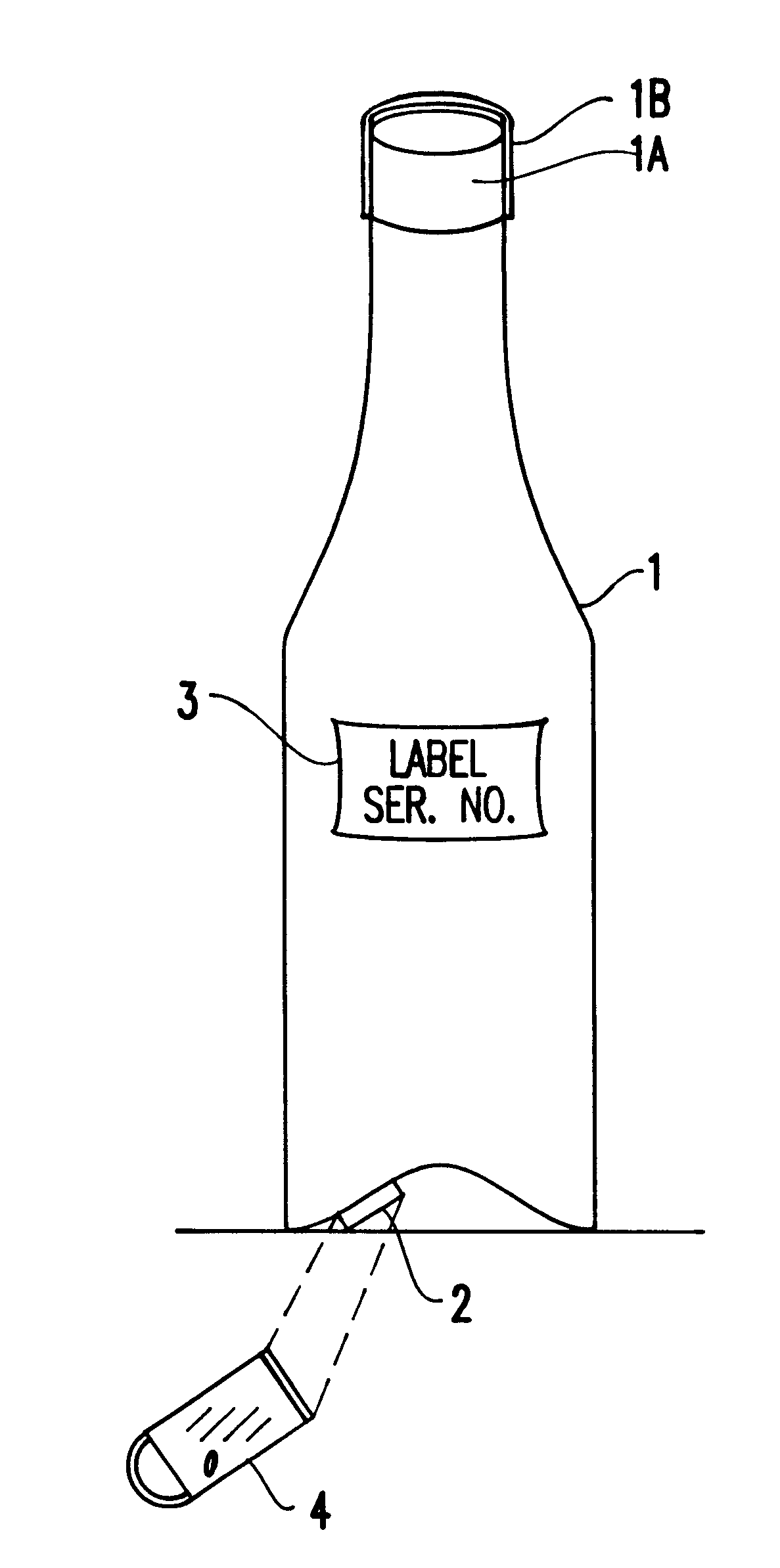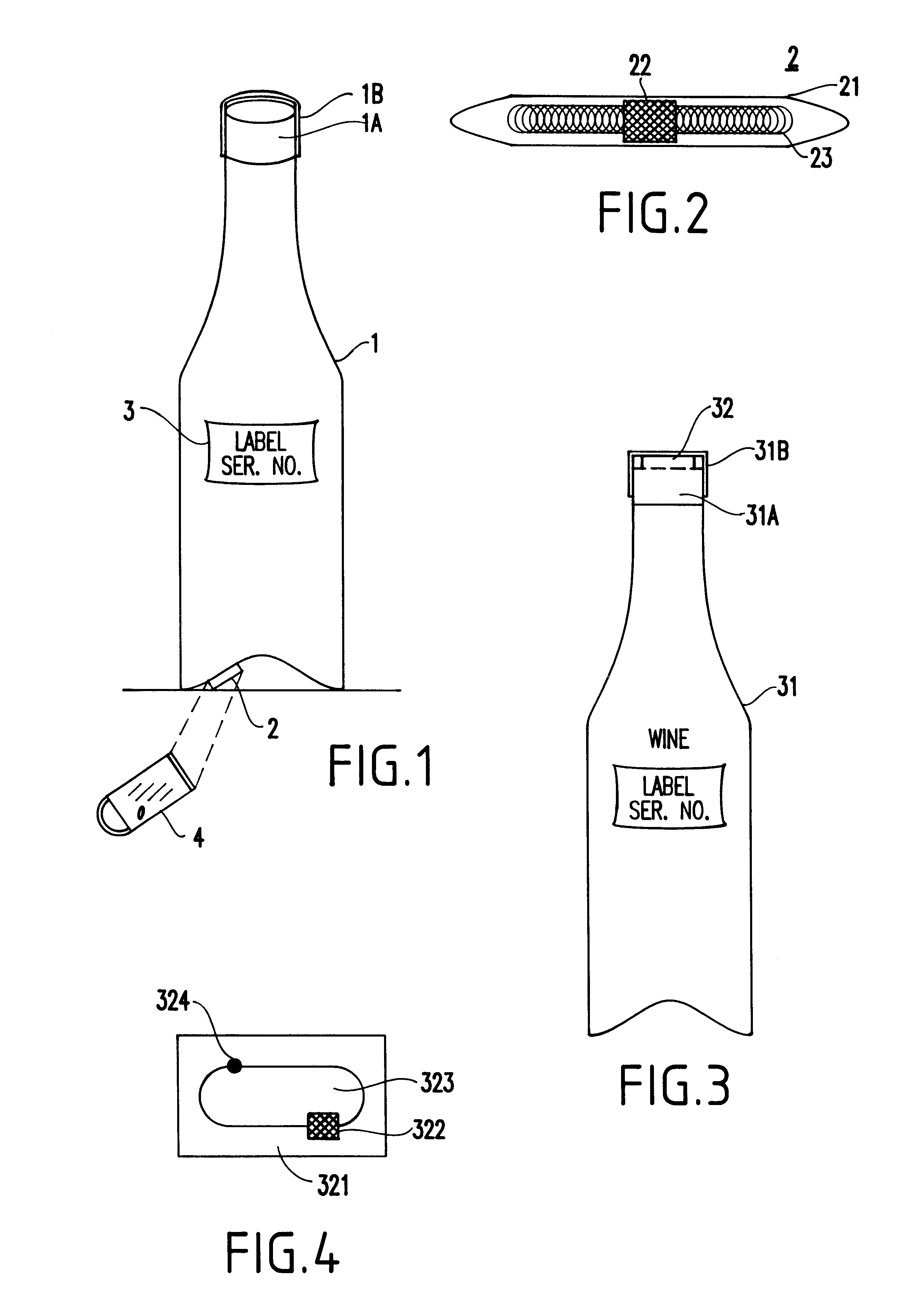Method and system for preventing counterfeiting of high price wholesale and retail items
a counterfeiting and high-price technology, applied in the field of methods and systems for preventing counterfeiting of expensive items, can solve the problems of inability to easily achieve the cooperation of the public in fighting counterfeiting, the failure of the tagging mechanism to engender (or strongly encourage) the customer's participation in helping to recognize counterfeited items, and the method suffers from several drawbacks
- Summary
- Abstract
- Description
- Claims
- Application Information
AI Technical Summary
Benefits of technology
Problems solved by technology
Method used
Image
Examples
first embodiment
Turning to FIGS. 1 and 7, as an example of an anti-counterfeiting system according to the present invention, an expensive wine (e.g., Dom Perignon '55 Brut, etc.) will be considered where the cost is such that it is essential that the bottles not be refilled and reused with counterfeit wine for resale.
First, prior to turning to exemplary applications, a system 70 for preventing counterfeiting of high value items will be generally described referring to the block diagram of FIG. 7.
As shown, the system 70 includes a processor 71, a tag 72 for being affixed to a high value item including a memory 73 for storing information related to the item to which the tag 72 is affixed, and a tag reader 74 (e.g., preferably a contact-free reader) for interrogating the tag 72. While the tag reader is shown separately from the processor 71, the tag reader could include the processor built therein.
Optionally, the processor may be connected to a remote flag setting / removing circuit 75 which can be set ...
second embodiment
As shown in FIGS. 3-5, an alternative method for preventing counterfeiting and achieving security for an item 31 (e.g., a bottle of rare wine) is to have a small flat tag 32, typically, though not necessarily, operating around 125 kHz that can be hidden between the cork 31A and the sealing cap 31B of the bottle. This tag 32 also can have the same chip design as described above. Such a tag is again unique in its code and cannot be duplicated readily.
Once the bottle is opened conventionally (e.g., the top covering seal 31B, typically made of foil or the like, of the bottle is removed), the tag is destroyed as it is exposed (e.g., to the ambient, to light, etc. depending upon the design and characteristics of the tag 32) or attached to the cover and the cork in a manner that causes the tag's chip circuit lines or one of the antenna lines to be severed.
For example, as shown in FIG. 4 which illustrates the magnified front details of the tag 32, the tag 32 includes a substrate 321 for mou...
third embodiment
FIG. 5 illustrates a third embodiment of the present invention in which a high-priced item 51 includes a tag 52 (e.g., similar to either of the ones illustrated in FIG. 2 or FIG. 4) which is concealed and attached to the underside of a vintner's label 53. The label includes first and second portions 53A, 53B (e.g., top and bottom), and the tag is attached to one of the portions (e.g., top portion) of the label. The label 53 preferably includes the serial number, as well as a tab 54 fixed to the portion of the label having the tag attached thereto. The tab 54 is for being grasped and pulled by a merchant upon sale of the item.
Additionally, the label 53 includes a perforation 55, separating the first and second portions 53A, 53B, respectively, of the label, for allowing the first and second portions to separate when the user (merchant) grasps and pulls on the tab, thereby to detach the label portion including the tag (e.g., the top portion of the label) from the non-tag carrying secon...
PUM
 Login to View More
Login to View More Abstract
Description
Claims
Application Information
 Login to View More
Login to View More - R&D
- Intellectual Property
- Life Sciences
- Materials
- Tech Scout
- Unparalleled Data Quality
- Higher Quality Content
- 60% Fewer Hallucinations
Browse by: Latest US Patents, China's latest patents, Technical Efficacy Thesaurus, Application Domain, Technology Topic, Popular Technical Reports.
© 2025 PatSnap. All rights reserved.Legal|Privacy policy|Modern Slavery Act Transparency Statement|Sitemap|About US| Contact US: help@patsnap.com



